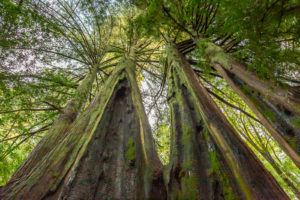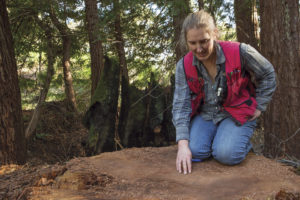Recent high-school graduate Zane Moore is sitting — or rather towering — with the masters of tall tree finders.
This summer Moore, 18, embarked on a mission to measure and record the locations of some of the tallest trees in the world: the coastal redwoods of the Santa Cruz Mountains. After traipsing day in and day out through dense forest, the San Jose native just finished up this month, busting records on “extreme” tree discoveries.
Before Zane Moore, there was only one known redwood tree south of San Francisco that reached 300 feet tall. He’s added six more to the list, along with 9 redwoods reaching 290 feet. Oh, and if that’s not impressive enough, he’s also discovered the tallest known California sycamore, the tallest bay laurel, the tallest Pacific madrone, and the tallest tan oak. Not bad for a summer’s (unpaid) work.
“The coolest thing is, I’ve never seen some of these old growth stands. They are gigantic — both wide and tall,” Moore said. “One of my favorite 300-footers I found about a mile away from a mill site and off trail, but it’s on a parcel of land untouched by loggers. Groves like that are really exciting because you realize very few have been there.”
The tree trekker
Moore, nicknamed the “tree trekker,” has long been an extreme tree hunter. He got the idea to scout old growth redwood stands after a 7-day, 34-mile hiking quest in Redwood National Park to find the secret location of Hyperion, the world’s tallest known living tree at 379.1 feet. He contacted Hyperion’s co-discoverer, Michael Taylor, who took an interest in the budding naturalist and sent him a $400 laser rangefinder to measure more tall trees with the offer to keep it if he was successful.

“I realized if he could find Hyperion without my assistance, I knew this guy had an unusually keen sense about trees,” said Taylor. “He reminded me of myself when I was young — the passion part of it.”
Game on. “I was on a quest to make him proud,” said Moore.
But where to start? After locating the other hardwoods earlier in the year, Moore focused his efforts on the southernmost range of the coastal redwoods, from Half Moon Bay to Watsonville. He got another leg up from Steve Singer, a Santa Cruz Mountains redwoods expert, who provided Moore with a map of old growth stands in the area. Singer had found the old growth stands using aerial photographs and a stereoscope, but had never been to many of them.
“It’s been really rewarding to me to see that, yes, these photos are accurate and where I mapped the stand is accurate,” Singer said.
On top of the excitement, the project has been physically demanding. Moore said he had to hike 13 miles round trip through dense second growth forests to get to the Peters Creek Grove in the Portola redwoods. He’s also schlepping a large load: two large backpacks that contain two tripods, a 7-pound laser, and the day’s provisions. He brings his father, who accompanied him on the Hyperion search, or a friend that has taken an interest in his quest.
“My dad absolutely loves it. He’ll come out with me every single weekend and find some more,” he said.
Looking down
To get an accurate measurement of the tallest trees, Moore has to scramble up a nearby hillside to look down on the treetops. He then measures the tree top to its base using surveying prisms and the laser rangefinder. Taylor and the co-founder of Hyperion, ecologist Steve Sillett, sent Moore a top-of-the-line laser rangefinder that can measure within 1-2 inches of accuracy, and taught him how to use it.
“The hard part about that is there’s foliage in the way when measuring, so multiple tripods are set up to get to the base,” Moore said. “You put a laser up on a hill and measure to a prism and then move the laser tripod to a new location and go back.”
Moore has scouted out 15 old growth stands within an area of 11 square miles since Memorial Day.
“It’s an amazing amount of ground to cover in such a short period of time,” said Singer.
The result has been more detail added to Singer’s maps, information that Singer and Moore hope will aid in conservation efforts.
“We want to get this information out, but we don’t want to get it out to people who will destroy the trees so we’ll keep it selective,” Singer said.
Keeping it secret
It’s not loggers they are most worried about, since these trees are on publicly protected land. It’s recreational climbers, an intrepid bunch of hobbyists who can easily damage the trees during their thrill-seeking. Foot traffic along the base of a tree also compacts and erodes the soil, which can prevent the tree from growing even taller.

Singer said there’s an entire ecosystem living in the treetops that deserve protection. His research has centered on marbled murrelets, small endangered seabirds that nest in old growth trees. The murrelets were the impetus behind Singer’s creation of old growth maps.
“I realized if we wanted to conserve this species we would have to know where its nesting sites were,” he said.
Singer said the next line of research will be studying the ecological conditions that allow old growth stands to flourish in particular spots, information that will be crucial to knowing where to focus efforts to stem the effects of climate change.
As for Zane, he’s off to Colorado State University in the fall, where he plans to study botany or music, maybe both. Perhaps the redwoods will one day lure him back.





